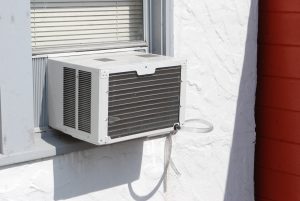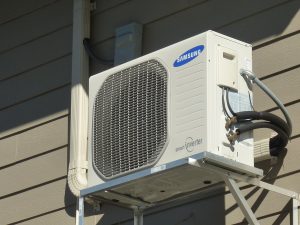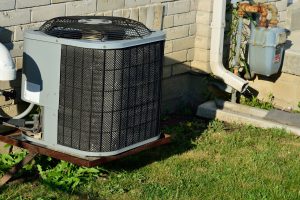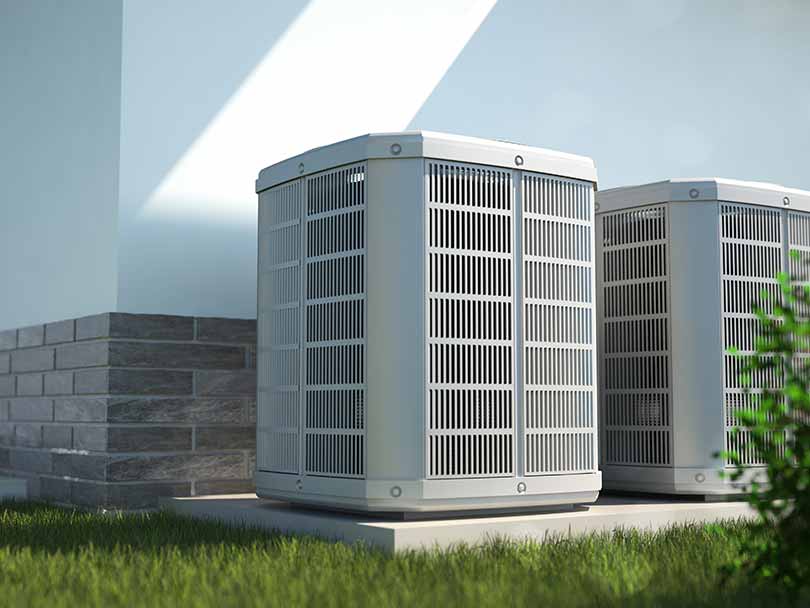By Pat Keegan and Brad Thiessen
It’s the right time of year to think about how to stay cool this summer. There are a few low- and no-cost cooling strategies, like using ceiling fans to keep air moving, turning off unused electrical devices and appliances, and blocking direct sunlight with window coverings. If you live in a climate with cool summer evenings, you can let cool air in late at night or early in the morning, then seal up the home to keep that air from leaking out.
If that’s not enough, you can install air conditioning. Below are three common options for home cooling. We included approximate cost estimates for each, but please be aware that costs are highly variable.
Window Units/Portable Cooling

A window A/C can be an effective way to cool a single room. Photo Credit: Paul Sullivan
Window A/C units or portable A/C units are the lowest cost approach. Portable units can be moved from room to room and come equipped with a length of duct to exhaust hot air out a nearby window. Window units are mounted in a window opening and cool one room. The efficiency of portable and window units has improved over the years, but none of them are as efficient as most central A/C units or a mini-split heat pump.
If you live in a hot, dry climate, you could consider an evaporative cooler (sometimes referred to as a swamp cooler). Window units have been around for a while, but now there are portable options available. Evaporative cooling units can be less expensive than traditional A/C, but don’t buy one until you do the research to determine how well evaporative cooling works in your local area. Whatever you choose, make sure it is rated for the size of the space you are cooling.
- Cost: $149 to $1,000 per new unit (depending on your climate and how many square feet you’re trying to cool)
Ductless Min-Split Heat Pumps

The condenser unit for a mini-split heat pump system is usually mounted on an exterior wall. Photo Credit: Gary Cziko
A ductless mini-split heat pump has a compressor outside the home that’s connected to air handler units in as many as four rooms. Each room’s temperature can be controlled separately. Ductless mini-splits are an especially good choice for homes without forced air ducting systems or with leaky or undersized ductwork. Heat pumps can also be a supplemental source of heat in the winter.
- Cost: approximately $3,000 to $10,000 (including installation)
Central Cooling

Central A/C systems typically have a compressor unit located outside the home. Photo Source: Open Grid Scheduler
If your home has forced air heating ductwork, it can be used for an A/C or heat pump unit. This is a good option if the ductwork is sized properly and doesn’t leak, and if ducts are in unheated attics or crawlspaces that are insulated. In some locations in the U.S., contractors can install evaporative cooling as a whole house system.
- Cost: Approximately $3,000 to $7,000 (not including repairs to ductwork)
As always, you can save energy and money by purchasing ENERGY STAR®-rated appliances and collecting a few quotes from licensed contractors.
We hope this information on home cooling options will start you on the path to a more comfortable home this summer.
Pat Keegan and Brad Thiessen of Collaborative Efficiency write on energy efficiency topics for the National Rural Electric Cooperative Association. For additional energy tips and information on Collaborative Efficiency visit: collaborativeefficiency.com/energytips.

